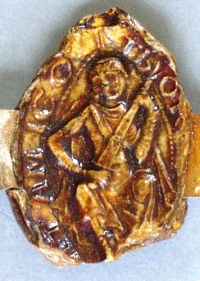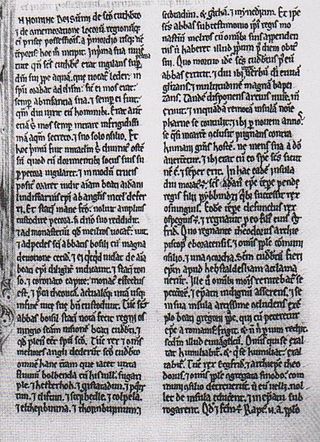Original Anglo-Saxon Liber Vitae
The text was originally of the 9th century, but was continually supplemented thereafter by entries made in the 10th century and later. [2]
The 9th-century core constitutes folios 15–45, with folio 47. [3] It is generally believed by scholars that it was produced in the church of Lindisfarne, though Monkwearmouth-Jarrow monasteries have also been suggested. [4] This had been composed c. 840. It has been damaged over time, and the original binding is now lost. [5] It consisted of parchment sheets on which were written lists of names, followed by blank sections for future additions. [6]
The book was at Durham by the later 11th century, as indicated by the list of Durham monks on folio 45 from the episcopate of Ranulf Flambard. [4] Later additions to the early core were made to folios 24r, 36r, 44v and 45r. [7]

Northumbria was an early medieval Anglo-Saxon kingdom in what is now Northern England and south-east Scotland.

Edgar was King of the English from 959 until his death. He became king of all England on his brother's death. He was the younger son of King Edmund I and his first wife Ælfgifu. A detailed account of Edgar's reign is not possible, because only a few events were recorded by chroniclers and monastic writers were more interested in recording the activities of the leaders of the church.

Eadred was King of the English from 26 May 946 until his death. He was the younger son of Edward the Elder and his third wife Eadgifu, and a grandson of Alfred the Great. His elder brother, Edmund, was killed trying to protect his seneschal from an attack by a violent thief. Edmund's two sons, Eadwig and Edgar, were then young children, so Eadred became king. He suffered from ill health in the last years of his life and he died at the age of a little over thirty, having never married. He was succeeded successively by his nephews, Eadwig and Edgar.
Symeonof Durham was an English chronicler and a monk of Durham Priory.

Thor Longus or Thor the Long was an early 12th-century Anglo-Saxon noble associated with Roxburghshire, a culturally Northumbrian and Brythonic Cumbric Celtic territory ruled by the Scottish king from the 11th-century onwards. A charter dating between 1107×1113 and 1124 claims that Thor the Long founded Ednam, previously a deserted waste granted to him by King Edgar of Scotland.

The bishop of Durham is responsible for the diocese of Durham in the province of York. The diocese is one of the oldest in England and its bishop is a member of the House of Lords. Paul Butler was the most recent bishop of Durham until his retirement in February 2024.
Æthelgeard, also Æthelheard was a 10th-century landowner who was known to have been involved in service to the royal family, likely an official of Eadwig.

The Libellus de exordio atque procursu istius, hoc est Dunhelmensis, ecclesie, in short Libellus de exordio, is a historical work of marked literary character composed and compiled in the early 12th-century and traditionally attributed to Symeon of Durham. It relates the history of bishopric and church of Durham and its predecessors at Lindisfarne and Chester-le-Street (Cunecacestre). It is sometimes also known as the Historia Dunelmensis ecclesiae.
The Historia Regum is a historical compilation attributed to Symeon of Durham, which presents material going from the death of Bede until 1129. It survives only in one manuscript compiled in Yorkshire in the mid-to-late 12th century, though the material is earlier. It is an often-used source for medieval English and Northumbrian history. The first five sections are now attributed to Byrhtferth of Ramsey.
David W. Rollason is an English historian and medievalist. He is a Professor in history at Durham University. He specialises in the cult of saints in Anglo-Saxon England, the history of Northumbria and in the historical writings of Durham, most notably producing a modern edition and translation of the Libellus de exordio and co-operating on an edition of the Durham Liber Vitae.

A confraternity book, also called a liber memorialis or liber vitae, is a medieval register of the names of people who had entered into a state of spiritual brotherhood (confraternity) with a church or monastery in some way, often by visiting it in the capacity of a pilgrim. Persons named in such a book were actively remembered in the prayers of the priests or monks. In many cases these books were established as early as the 8th century and continued up to the 13th century. So-called Jahrtagsbücher are in many ways their successors.

The Liber Eliensis is a 12th-century English chronicle and history, written in Latin. Composed in three books, it was written at Ely Abbey on the island of Ely in the fenlands of eastern Cambridgeshire. Ely Abbey became the cathedral of a newly formed bishopric in 1109. Traditionally the author of the anonymous work has been given as Richard or Thomas, two monks at Ely, one of whom, Richard, has been identified with an official of the monastery, but some historians hold that neither Richard nor Thomas was the author.
Northman was a late 10th-century English earl, with a territorial base in Northumbria north of the River Tees. A figure with this name appears in two different strands of source material. These are, namely, a textual tradition from Durham witnessed by Historia de Sancto Cuthberto and by the Durham Liber Vitae; and the other an appearance in a witness list of a charter of King Æthelred II dated to 994. The latter is Northman's only appearance south of the Humber, and occurred the year after Northumbria was attacked by Vikings.
Ranulf de Briquessart was an 11th-century Norman magnate and viscount.
De Iniusta Vexacione Willelmi Episcopi Primi is a late 11th-century historical work detailing the trial of William de St-Calais, a medieval Norman Bishop of Durham from 1081 to 1096. It is the first surviving detailed account of an English trial before the king, and as such is an important source for historians.

Tidfrith or Tidferth was an early 9th-century Northumbrian prelate. Said to have died on his way to Rome, he is the last known Anglo-Saxon bishop of Hexham. This bishopric, like the bishopric of Whithorn, probably ceased to exist, and was probably taken over by the authority of the bishopric of Lindisfarne. A runic inscription on a standing cross found in the cemetery of the church of Monkwearmouth is thought to bear his name.
Billfrith is an obscure Northumbrian saint credited with providing the jewel and metalwork encrusting the former treasure binding of the Lindisfarne Gospels. His name is thought to mean "peace of the two-edge sword".

The Historia de Sancto Cuthberto is a historical compilation finished some time after 1031. It is an account of the history of the bishopric of St Cuthbert—based successively at Lindisfarne, Norham, Chester-le-Street and finally Durham—from the life of St Cuthbert himself onwards. The latest event documented is a grant by King Cnut, c. 1031. The work is a cartulary chronicle recording grants and losses of property as well as miracles of retribution, under a loose narrative of temporal progression. The text survives in three manuscripts, the earliest of which dates from around 1100. The original version of the text is not thought to be extant; rather, all surviving manuscripts are thought to be copies of an earlier but lost exemplar. The Historia is one of the sources for the histories produced at Durham in the early 12th century, particularly the Historia Regum and Symeon of Durham's Libellus de Exordio.
Andrew Wareham is a British historian who has written numerous books and articles on Anglo-Saxon history, Anglo-Norman history and the hearth tax. He is employed as a reader in the department of humanities at Roehampton University, London.

The New Minster Liber Vitae is a confraternity book produced in Winchester, in southern England, in 1031. It records the names of visitors to the New Minster, Winchester and contains other information too, as well as a contemporary image of King Cnut the Great and his second wife Queen Emma of Normandy.











